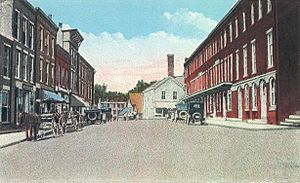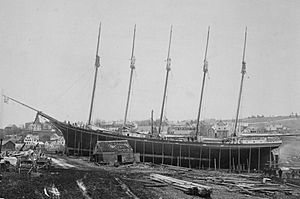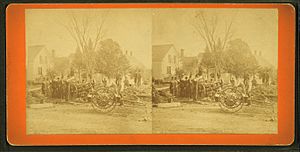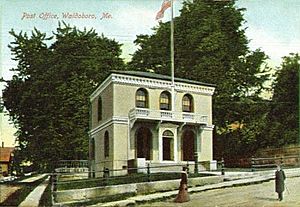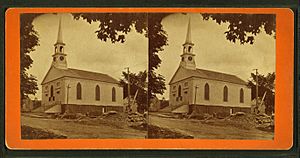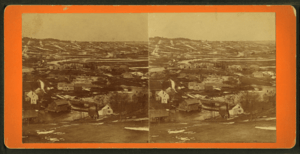Waldoboro, Maine facts for kids
Quick facts for kids
Waldoboro, Maine
|
|
|---|---|
| Motto(s):
"Home of the Five Masted Schooner"
|
|
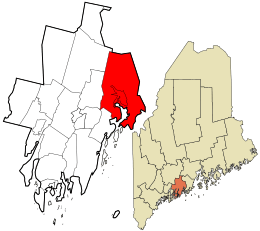
Location in Lincoln County and the state of Maine
|
|
| Country | United States |
| State | Maine |
| County | Lincoln |
| Incorporated | June 29, 1773 |
| Named for | Samuel Waldo |
| Area | |
| • Total | 78.86 sq mi (204.25 km2) |
| • Land | 71.50 sq mi (185.18 km2) |
| • Water | 7.36 sq mi (19.06 km2) |
| Population
(2020)
|
|
| • Total | 5,154 |
| • Density | 72/sq mi (27.8/km2) |
| Time zone | UTC-5 (Eastern (EST)) |
| • Summer (DST) | UTC-4 (EDT) |
| ZIP Code |
04572
|
Waldoboro is a town in Lincoln County, Maine, United States. In 2020, 5,154 people lived there. Waldoboro became an official town in 1773. It was known for building ships and being a busy port along the Medomak River.
Today, Waldoboro still has a strong connection to farming and fishing. People there are also excited about old traditions. These include making things from natural fibers, cheesemaking, and brewing drinks on farms. The town is becoming a popular place to visit. It has beautiful river views, a lively arts community, and an interesting history. It was once a settlement for people from Germany.
Contents
History
In 1629, the land that is now Waldoboro was given to two men, John Beauchamp and Thomas Leverett. It was called the Muscongus Patent. A "patent" was like a special permission to own land. This land claim was not used for a long time.
In 1719, John Leverett, a descendant of Thomas Leverett, brought the old claim back to life. He formed a group called the Lincolnshire Proprietors. These were ten people who shared ownership of the land. Later, in 1729, General Samuel Waldo bought most of the land. After that, it became known as the Waldo Patent.
The first village in this area was called Broad Bay. People started settling there between 1733 and 1740. However, the village was attacked in 1746 by Native Americans who were allies of New France. Houses were burned, and some people were killed or taken captive. The people who survived ran to nearby towns. Peace returned in 1748.
It was hard to get new settlers to this area because of the past attacks. So, from 1741 to 1753, Samuel Waldo's son, Jonathan Waldo, went to Germany. He invited about 1,500 immigrants to come to Waldoboro. Most of these people came from the Rhineland area of Germany. They came to find better opportunities, not for religious reasons. Many settled on the west side of Broad Bay. On June 29, 1773, the town officially became Waldoborough. It was named after Samuel Waldo, the original owner of the land.
Waldoboro became the main town for Lincoln County in 1786. This meant it was the center for government. However, this role later moved to Wiscasset in 1880. Farmers in Waldoboro grew crops like hay and potatoes.
The Knox and Lincoln Railroad came to town, which helped Waldoboro grow. Many businesses started up. These included a place that made iron, a mill for rope fibers, and mills for grinding grain. There were also places that made furniture, doors, and carriages. People also worked with marble and granite, and made pottery.
But the most important business was ship building. In 1880, eight large ships were built here. Maine became famous for its shipbuilding in the 1800s. Waldoboro was where the Governor Ames was launched in 1888. This was the first five-masted schooner, a type of sailing ship. The Governor Ames was built at the Leavitt Storer Shipyard in Waldoboro. The town also had a special building called a custom house, built in 1857. This was where taxes were collected on goods coming into the port.
Waldoboro is also known for its special style of hooked rugs. Other famous things include the Waldoboro green neck turnip, Moody's Diner, Morse's Sauerkraut, and Fawcetts Toy Museum.
Historic Places to See
Waldoboro has several places that are listed on the National Register of Historic Places. These are important buildings and sites that are kept safe because of their history.
- German Church and Cemetery
- Hutchins House (Hall Funeral Home)
- Ludwig, Godfrey, House
- U.S. Customhouse and Post Office
- Waldo Theatre built by Carroll Cooney
- Waldoborough Town Pound
- Wetherill Site
Geography
Waldoboro covers a total area of about 78.86 square miles (204.25 square kilometers). Most of this area, about 71.50 square miles (185.18 square kilometers), is land. The rest, about 7.36 square miles (19.06 square kilometers), is water. Waldoboro is located at the point where boats can travel furthest up the Medomak River.
Population Information
| Historical population | |||
|---|---|---|---|
| Census | Pop. | %± | |
| 1790 | 1,717 | — | |
| 1800 | 1,511 | −12.0% | |
| 1810 | 2,160 | 43.0% | |
| 1820 | 2,449 | 13.4% | |
| 1830 | 3,118 | 27.3% | |
| 1840 | 3,661 | 17.4% | |
| 1850 | 4,199 | 14.7% | |
| 1860 | 4,568 | 8.8% | |
| 1870 | 4,174 | −8.6% | |
| 1880 | 3,758 | −10.0% | |
| 1890 | 3,505 | −6.7% | |
| 1900 | 3,145 | −10.3% | |
| 1910 | 2,656 | −15.5% | |
| 1920 | 2,421 | −8.8% | |
| 1930 | 2,311 | −4.5% | |
| 1940 | 2,497 | 8.0% | |
| 1950 | 2,536 | 1.6% | |
| 1960 | 2,882 | 13.6% | |
| 1970 | 3,146 | 9.2% | |
| 1980 | 3,985 | 26.7% | |
| 1990 | 4,601 | 15.5% | |
| 2000 | 4,916 | 6.8% | |
| 2010 | 5,075 | 3.2% | |
| 2020 | 5,154 | 1.6% | |
| U.S. Decennial Census | |||
In 2010, there were 5,075 people living in Waldoboro. The town had 2,171 households. About 28.5% of these households had children under 18 living with them. The average age of people in Waldoboro was 43.5 years old.
Transportation
The town is served by major roads like U.S. Route 1 and state routes 32, 220, and 235.
Education
Regional School Unit 40 runs the public schools in Waldoboro.
- Medomak Valley High School — For students in Grades 9–12.
- Medomak Valley Middle School — For students in Grades 7–8.
- Miller Elementary School — For students in Grades K–6.
The Waldoboro Public Library also serves the community.
Famous People from Waldoboro
Many interesting people have connections to Waldoboro:
- Benjamin Brown — A politician who was also a doctor in Waldoboro.
- Carroll Trowbridge Cooney — A college football player and owner of the Waldo Theatre.
- Robert Creeley — A well-known poet.
- Tristan Dyer — A filmmaker and veteran, born in Waldoboro.
- Ezra B. French — A politician who served in the U.S. House of Representatives.
- Harriet Newell Haskell — An important educator and school leader.
- Conrad Heyer — A veteran of the Revolutionary War. He is one of the earliest-born people ever photographed.
- John Harvey Lovell — A naturalist and author, born and lived in Waldoboro.
- Sebastian Streeter Marble — The 41st governor of Maine.
- John William McCormack — A U.S. Representative and Speaker of the House.
- Frederick G. Payne — A U.S. Senator and the 60th governor of Maine.
- Isaac Reed — A U.S. Congressman, born in Waldoboro.
- Frederick Robie — The 39th governor of Maine, who practiced medicine here.
- Aaron Robinson — A musician and composer.
- Augusta Emma Stetson — A religious leader, born in Waldoboro.
- Clyde Sukeforth — A Major League Baseball player and scout. He helped sign Jackie Robinson.
- David Trahan — A politician, logger, and lobbyist.
- Samuel Waldo — A merchant, soldier, and the original owner of the land for Waldoboro.
See also
 In Spanish: Waldoboro (Maine) para niños
In Spanish: Waldoboro (Maine) para niños


